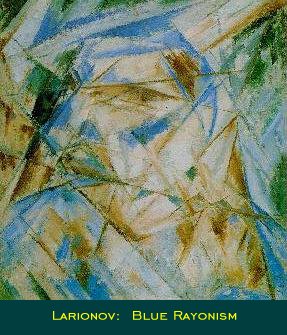

 Rayonism, an ephemeral style which lasted only about a year, was not only unique to Russia, but to the entire world. It was invented by Mikhail Larionov and practiced mostly by him and his companion Natalia Goncharova. Introduced to the public in 1913 at the Target exhibition, Rayonism was described as "naturally encompassing all existing styles and forms of the art of the past, as they, like life, are simply points of departure for a Rayonist perception and construction of a picture" (Gray, 140-1). The central feature of Rayonism is the "crossing of reflected rays from various objects;" to this end, its most powerful tools are color and line. Although short-lived, Rayonism proved to be a crucial step in the development of Russian abstract art. As Larionov said, it represented the "true freeing of art" from the former "realistic" conventions that had so "oppressed" the artistic community (Gray, 141).
Rayonism, an ephemeral style which lasted only about a year, was not only unique to Russia, but to the entire world. It was invented by Mikhail Larionov and practiced mostly by him and his companion Natalia Goncharova. Introduced to the public in 1913 at the Target exhibition, Rayonism was described as "naturally encompassing all existing styles and forms of the art of the past, as they, like life, are simply points of departure for a Rayonist perception and construction of a picture" (Gray, 140-1). The central feature of Rayonism is the "crossing of reflected rays from various objects;" to this end, its most powerful tools are color and line. Although short-lived, Rayonism proved to be a crucial step in the development of Russian abstract art. As Larionov said, it represented the "true freeing of art" from the former "realistic" conventions that had so "oppressed" the artistic community (Gray, 141).
John E. Bowlt suggests that Larionov's Rayonist theory might have been influenced by the developments in photography and cinematography: "[In] 1912-13 the Moscow photographer A. Trapani invented the photographic technique of "ray gum" -- a version of the gum-arabic process -- which enabled the photographer to create the illusion of a radial, fragmented texture. . . . Of possible relevance to Larionov's theory of Rayonism was the peculiarly "broken" texture that Mikhail Vrubel favored in so many of his works in the 1890s and 1900s -- a technique admired by a number of young Russian artists. Moreover, Vrubel's theory of visual reality came very close to Larionov's formulation, as the following statement by Vrubel would indicate: "The contours with which artists normally delineate the confines of a form in actual fact do not exist -- they are merely an optical illusion that occurs from the interaction of rays falling onto the object and reflected from its surface at different angles. In fact, at this point you get a 'complementary color' -- complementary to the basic, local color . . . "" (Russian Art of the Avant-Garde, 92-3).
In 1913, in the miscellany Donkey's Tail and Target, Larionov published a pamphlet entitled "Rayonist Painting," which contained an extensive description of the theory and practice of Rayonist art. Below are the most important excerpts:
"We do not sense the object with our eye, as it is depicted conventionally in pictures and as a result of following this or that device; in fact, we do not sense the object as such. We perceive a sum of rays proceeding from a source of light; these are reflected from the object and enter our field of vision.
Consequently, if we wish to paint literally what we see, then we must paint the sum of rays reflected from the object. But in order to receive the total sum of rays from the desired object, we must select them deliberately -- because together with the rays of the object being perceived, there also fall into our range of vision reflected reflex rays belonging to other nearby objects. Now, if we wish to depict an object exactly as we see it, then we must depict also these reflex rays belonging to other objects -- and then we will depict literally what we see . . .
Now, if we concern ourselves not with the objects themselves but with the sums of rays from them, we can build a picture in the following way:
The sum of rays from object A intersects the sum of rays from object B; in the space between them a certain form appears, and this is isolated by the artist's will . . .
Perception, not of the object itself, but of the sum of rays from it, is, by its very nature, much closer to the symbolic surface of the picture than is the object itself. This is almost the same as the mirage which appears in the scorching air of the desert and depicts distant towns, lakes, and oases in the sky (in concrete instances). Rayonism erases the barriers that exist between the picture's surface and nature.
A ray is depicted provisionally on the surface by a colored line." (Russian Art of the Avant-Garde, 93-100) [A.B., B.B., and C.B.].
